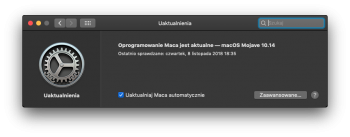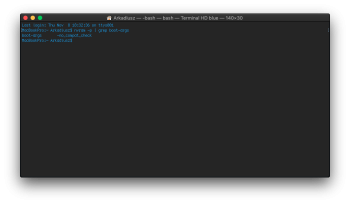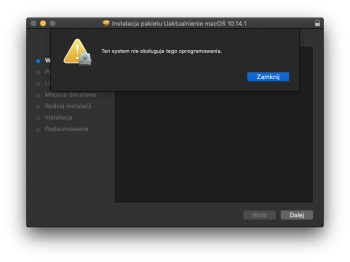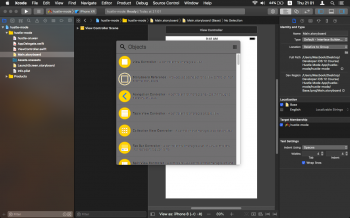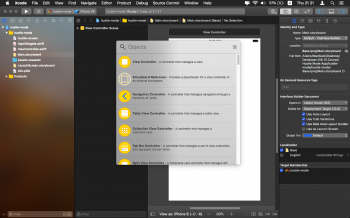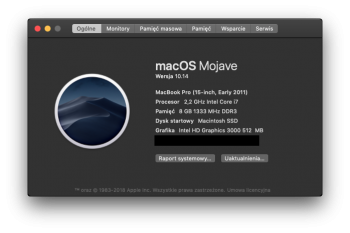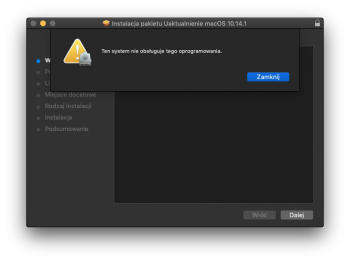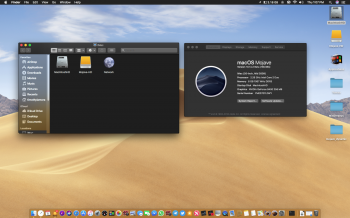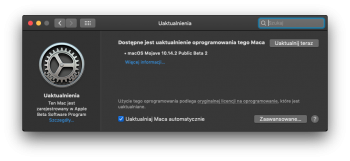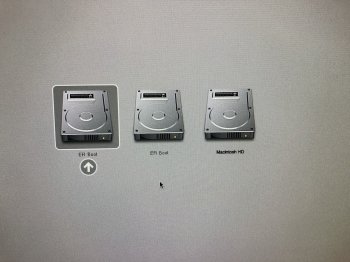Got a tip for us?
Let us know
Become a MacRumors Supporter for $50/year with no ads, ability to filter front page stories, and private forums.
macOS 10.14 Mojave on Unsupported Macs Thread
- Thread starter dosdude1
- WikiPost WikiPost
- Start date
- Sort by reaction score
You are using an out of date browser. It may not display this or other websites correctly.
You should upgrade or use an alternative browser.
You should upgrade or use an alternative browser.
- Status
- The first post of this thread is a WikiPost and can be edited by anyone with the appropiate permissions. Your edits will be public.
10.14.2 Beta 1 to 10.14.2 Beta 2 update
Successfully updated OTA and Mojave Patcher | MacOS Post Install.
View attachment 802325
Must have been hundreds of times that I attempted to updates of betas on my Mojave unsupported Macs. Failed several times but succeeded when I specifically followed the following steps.
Hope these detailed steps are helpful.
- System Preferences | Software Update, then click on "update now". (goes without saying ... must be on developers or public beta program)
- It will reboot and then show "installing software update ...xx minutes remaining)
- When finishing step 2, it will again reboot. Now the next step (4) is important.
- Option-Key and boot to "Mojave Patcher" 1.2.3 thumb drive.
- run MacOS Post Install. Check on "Force Rebuild Cache" and then reboot.
- It will boot with the message "Finishing Update" on black screen.
- Then you are done!
Huh...That's just what I did when I tried the 14.1 OTA update, and I couldn't get it to boot at all.
Eventually, I made a new thumb with Patcher 1.2.3, letting it pull the 14.1 update from Apple.
I ran the post install util, but I don't believe I rebuilt the cache. I got the "Your computer couldn't restart ..." message (which I haven't seen in years). So I booted back into the patcher, forced the rebuild and booted again...eventually getting a black screen with a mouse cursor. Did a hard shutdown and rebooted, and eventually got to the login screen. Logged in and had 14.1 installed, along with a pop up message warning third party...somethings...had been disabled because they were preventing boot. I know should have written it down, but it was a 6 am hail mary attempt to get it going on my way out the door to work. The message said those items would be re-enabled when called. Really wish I could remember what it was now...
Anyway, seems to be ok.
Updating now my iMac late 2009 to 10.14.1For anyone having problems on an iMac 10,1 (Late 2009):
I did the OTA update and ended up in a boot loop. I then tried booting my patched USB thumb drive with 10.14.0 on it to run the Post-Install stuff, but the boot process would always get stuck at the progress bar, which eventually reaches 100% without anything happening further. I think some users described the same behavior on their machines on this thread before.
I then downloaded 10.14.1 using Mojave Patcher 1.2.3 and created a new thumb drive. This time it booted fine and I was able to run Post-Install which fixed everything and I can boot the machine normally again.
Last edited:
i did a clean install of mojave before installing the 780m (while using the defective but still usable original 6970) , cant remember any patches or nothing abnormal while installing, everything was pretty smooth, got installed but no graphic acceleration, the original card was even worse, since weird colors kind of inverted were all over the place, after installing the 780m colors came back to normal but no acceleration and no drivers available, so im stocked here.Probably because when you ran the patcher you accidentally selected "video card patch". You cannot use the patched ioaccelerator2 kext with a supported card format or manually extracteinstall the correct kexts.
I have a problem with update Mojave do 10.14.1...
nvram -p | grep boot-args
boot-args -no_compat_check
You should use this: https://support.apple.com/kb/DL1981
And you must have an APFS file system.
But I'd advise to have a mac with i5/i7 cpu, otherwise I cannot guarantee that the update will be successful.
Hey guys. Have this problem using XCode. Nothing terrible, but maybe there's a solution for this? Thanks.
[doublepost=1541705067][/doublepost]
[doublepost=1541705067][/doublepost]
Problem solved by using @pkouame hybrid mode. Many thanksHey guys. Have this problem using XCode. Nothing terrible, but maybe there's a solution for this? Thanks.
Attachments
Updated to 10.14.1 succesfuly.Updating now my iMac late 2009 to 10.14.1
View attachment 797301 View attachment 797302 View attachment 797303 View attachment 797304
View attachment 797317 View attachment 797306 View attachment 797308View attachment 797311
Current Hardware Support Status:
- Machine Support
- Early-2008 or newer Mac Pro, iMac, or MacBook Pro:
- MacPro3,1
- MacPro4,1
- iMac8,1
- iMac9,1
- iMac10,x
- iMac11,x (systems with AMD Radeon HD 5xxx and 6xxx series GPUs will be almost unusable when running Mojave. More details are located in the Current Issues section below.)
- iMac12,x (systems with AMD Radeon HD 5xxx and 6xxx series GPUs will be almost unusable when running Mojave. More details are located in the Current Issues section below.)
- MacBookPro4,1
- MacBookPro5,x
- MacBookPro6,x
- MacBookPro7,1
- MacBookPro8,x
- Late-2008 or newer MacBook Air or Aluminum Unibody MacBook:
- MacBookAir2,1
- MacBookAir3,x
- MacBookAir4,x
- MacBook5,1
- Early-2009 or newer Mac Mini or white MacBook:
- Macmini3,1
- Macmini4,1
- Macmini5,x
- MacBook5,2
- MacBook6,1
- MacBook7,1
- Early-2008 or newer Xserve:
- Xserve2,1
- Xserve3,1
Current Issues
- Video Card Support
- Pre-Metal AMD video cards (Radeon HD 6xxx series and older)
- Pre-Metal Nvidia video cards (GeForce 5xx series and older)
- Pre-Metal Intel video cards (Intel HD Graphics 3000 and Intel HD Graphics Arrandale)
Current Issues by Hardware
- Graphics anomalies: Currently, pre-metal video cards used in Mojave will produce a weird darkish grey Menu Bar and Finder sidebar when using the light theme. In the dark theme, these anomalies are not present, while other, less obvious anomalies are present (window corners may not render properly, bottom part of dock menus may have artifacts). A workaround for graphics anomalies in light mode is to enable Reduce Transparency in System Preferences > Accessibility > Display (this might create additional side effects beside the obvious loss of transparency as some systems with pre-metal AMD graphics render the dock in dark gray).
- AMD Radeon HD 5xxx/6xxx series GPU acceleration: Currently, it is not possible to get full graphics acceleration when running Mojave on a system with a Radeon HD 5xxx or 6xxx series GPU. Mojave will be almost UNUSABLE without graphics acceleration. This includes the 15" and 17" MacBook Pro systems (MacBookPro8,2 and 8,3). If you want to enable GPU acceleration on these machines, you'll need to disable the AMD GPU (This will work on MacBook Pro 8,2 and 8,3 systems ONLY. You CANNOT disable the AMD GPU in an iMac.) Weird colors will also be produced when running Mojave with one of these video cards installed/enabled. To disable the AMD GPU on a 2011 MacBook Pro 8,2 or 8,3, follow the guide found here.
- Early-2008 Mac Pro (MacPro3,1) GPU support: When running Mojave, you CANNOT use a newer AMD video card EVEN IF it is a Metal-compatible card and is supported in Mojave. The newer AMD drivers used in Mojave require the SSE4.2 instruction set, which the MacPro3,1 does not support. There is no way around this at this time. Your only GPU upgrade options for MacPro3,1 systems are Nvidia cards, which work perfectly fine.
- Built-in iSight cameras: Currently, built-in iSight cameras do not work correctly on some machines. It seems to be hit or miss, but when installing, expect your iSight camera to be non-functional.
- Trackpad (MacBook5,2 affected only). Trackpad multi-finger gestures on the MacBook5,2 not supported in Mojave. While the trackpad works and is fully usable, Mojave detects it as just a standard mouse, preventing you from changing some trackpad-oriented settings.
- Unsupported WiFi modules in some systems. Macs that use the Broadcom BCM4321 WiFi module will not have functional WiFi when running Mojave. A fix for this is to open up your machine and install a compatible WiFi card. Machines affected include some MacPro3,1, MacBook5,2, MacBookPro4,1, iMac8,1, Macmini3,1, and MacBookAir2,1 systems. Please note that not all these machines will have an unsupported card, this is just a list of machines known to have shipped with that card in some configurations.
- App Store Crashing: Some users have reported crashing upon opening the App Store. This is caused by App Store videos and can be worked around by disabling video autoplay and not viewing App Store videos. This is not a fix, this is a workaround. Safari may also experience crashes with certain kinds of embedded videos.
Installation:
- Graphics anomalies:
- All machines
- AMD GPU acceleration:
- All machines with a Radeon HD 5xxx or 6xxx series GPUs (these systems will be almost unusable when running Mojave. More details are located in the Current Issues section above.)
- AMD GPU support:
- MacPro3,1
- Built-in iSight camera:
- All machines, hit or miss
- Trackpad:
- MacBook5,2
- Unsupported WiFi modules:
- All machines with Broadcom BCM4321 WiFi modules
- App Store Crashing:
- All machines with Radeon HD 4xxx series GPUs
To install on your machine, you can download and run the macOS Mojave Patcher application, which will let you download a copy of the latest installer app from Apple and create a bootable installer drive for use on unsupported Macs. It contains all the patches necessary to achieve the hardware support listed above. The installation guide can be found here and an installation guide video here.
APFS ROM Patcher:
Warning: This tool could irreversibly brick your EFI chip. Please exercise caution with machines that have multiple EEPROM definitions. Relevant information can be found here and here. The APFS ROM patcher is currently unavailable.
Mojave Builds and Installer Versions (Developer Preview, Public Beta):
2018/06/04 - 2018/09/12 10.14.0 DP1 - DP11, PB1 - PB10
2018/06/04 DP1, build 18A293u, installer 14.0.082018/09/24 10.14.0 Final, build 18A391, installer 14.0.22
2018/06/19 DP2, build 18A314h, installer 14.0.11
2018/06/26 PB1, build 18A314k, installer 14.0.11
2018/07/03 DP3, build 18A326g, installer 14.0.12
2018/07/06 PB2, build 18A326h, installer 14.0.12
2018/07/16 DP4, 2018/07/17 PB3, build 18A336e, installer 14.0.14
2018/07/30 DP5, 2018/07/31 PB4, build 18A347e, installer 14.0.15
2018/08/06 DP6, 2018/08/06 PB5, build 18A353d, installer 14.0.16
2018/08/13 DP7, 2018/08/13 PB6, build 18A365a, installer 14.0.17
2018/08/20 DP8, 2018/08/20 PB7, build 18A371a, installer 14.0.18
2018/08/27 DP9, 2018/08/27 PB8, build 18A377a, installer 14.0.20
2018/09/04 DP10, 2018/09/04 PB9, build 18A384a, installer 14.0.21
2018/09/12 DP11, 2018/09/12 PB10, build 18A389, installer 14.0.21
2018/09/25 - 2018/10/23 10.14.1 DP1 - DP5, PB1 - PB5, installation issues
2018/09/25 10.14.1 DP1, 2018/09/27 PB1, build 18B45d, installation issues2018/10/30 10.14.1 Final, build 18B75, installer 14.1.0
2018/10/02 10.14.1 DP2, 2018/10/02 PB2, build 18B50c, installation issues
2018/10/08 10.14.1 DP3, 2018/10/08 PB3, build 18B57c, installation issues
2018/10/17 10.14.1 DP4, 2018/10/17 PB4, build 18B67a, installation issues
2018/10/23 10.14.1 DP5, 2018/10/23 PB5, build 18B73a, installation issues
2018/10/31 10.14.2 DP1
2018/10/31 10.14.2 DP1, build 18C31g
2018/11/07 10.14.2 DP2, build 18C38b
Credits:
@dosdude1 - Developed macOS Mojave Patcher.
@parrotgeek1 - Developed LegacyUSBInjector, SIPManager, and NDRVShim. (Source Code)
@Czo - Developed SUVMMFaker. (Source Code)
@Badruzeus - Discovered that Sierra OpenGL drivers work in Mojave.
@ASentientBot - Fixed Nvidia kernel panic, Core 2 Duo kernel panic, and iSight.
@jackluke - Narrowed down cause of Core 2 Duo kernel panic.
Moderator Note:
Please do not ask for, or provide help getting developers profile information to access unauthorised beta software on MacRumors. If you are not a developer, sign up to the Apple Beta Software Program to get the official public beta releases.
I use macOSUpd10.14.1.pkg and do not work...You should use this: https://support.apple.com/kb/DL1981
And you must have an APFS file system.
But I'd advise to have a mac with i5/i7 cpu, otherwise I cannot guarantee that the update will be successful.
I have APFS... What is wrong?
Attachments
Many thanks for the more comprehensive list. This time it worked without the gpt error (screenshot).
So Mojave is installed on RAID0 successfully but diskutil shows it is still hfs (screenshot). If I run:
diskutil apfs convert disk4s2
Will it convert and boot OK? I am confused about your comment JHFS+ only in the second post
View attachment 802187View attachment 802188
[doublepost=1541619969][/doublepost]
Seems not!
test$ diskutil apfs convert disk4s2
Converting the volume on disk4s2 to an APFS Volume on an APFS Container
Started APFS operation on disk4s2 Untitled
Converting HFS Volume to an APFS Container which will export one APFS Volume
The target is the Journaled HFS+ volume "Untitled" backed by the GPT partition disk4s2
The target is a macOS system disk
Exiting conversion operations with error code -69546
Error: -69546: Conversion to APFS of a macOS system volume is only allowed in the OS Installer Environment
Tests-Mac-Pro:~ test$
I tried when booted from another disk and same message, so it seems not.
Mac-Pro:~ testnvme$ diskutil apfs convert disk4s2
Converting the volume on disk4s2 to an APFS Volume on an APFS Container
Started APFS operation on disk4s2 Untitled
Converting HFS Volume to an APFS Container which will export one APFS Volume
The target is the Journaled HFS+ volume "Untitled" backed by the GPT partition disk4s2
The target is a macOS system disk
Exiting conversion operations with error code -69546
Error: -69546: Conversion to APFS of a macOS system volume is only allowed in the OS Installer Environment
Anyone know a workaround?
If not, maybe the post on page 410 that started this odyssey should be modified/deleted b/c it has been overtaken by changes made by Apple and is no longer 100% correct!
Mac-Pro:~ testnvme$
Maybe that might interest you.
Last edited:
I use macOSUpd10.14.1.pkg and do not work...
I have APFS... What is wrong?
I don't know your language so can't understand exactly your error during pkg installer, but you could try to enroll in Dev/Public beta and update to the last beta through OTA System Update prefpane.
Anyway try this from Mojave Terminal:
sudo installer -pkg /path/to/package.pkg -target /
Dark ModeCan you send me a print of Dark Mode?
Thank you
Attachments
I don't know your language so can't understand your error into pkg installer, but you could try to enroll in public beta and update to the last beta through OTA System Update prefpane.
... to translate: "This system do not support this software"
This is normal that i must enroll public beta to update system?
You cold download 10.14.1 from the MacOS Mojave patcher 1.2.3 by clicking the tools at the top then making a new patcher then install over your existing macOSI use macOSUpd10.14.1.pkg and do not work...
I have APFS... What is wrong?
sudo installer -pkg /Volumes/ArchiveDrive/macOSUpd10.14.1.pkg -target /I don't know your language so can't understand exactly your error during pkg installer, but you could try to enroll in Dev/Public beta and update to the last beta through OTA System Update prefpane.
Anyway try this from Mojave Terminal:
sudo installer -pkg /path/to/package.pkg -target /
Password:
installer: Error - Ten system nie obsługuje tego oprogramowania. ... to translate: "This system do not support this software"
... to translate: "This system do not support this software"
This is normal that i must enroll public beta to update system?
Try installing pkg from Terminal, if doesn't work then enroll into a public beta profile, it follows another route so should work out-of-the-box, after update re-do postinstall.
The issue of your system not supported I believe is a check inside the installer pkg maybe due to the Distribution file that needs to be patched.
Now i enroll acces to beta program... and i have a update 10.14.2 beta 2...
I try to install this beta update...
How to patch a Distribution file?
From beta enrollment you don't need to patch the Distribution, anyway I haven't focused much on it, so you can try to update from there but before just for safety take a backup of your important files. You will not lose data, but for safety do a little backup, on your machine updating should go fine.
I think you have smoother windows corners than me.Dark Mode
Hy,
Ich hatte Macbook Pro 4.1 wih the follovin
wlan card :
0x14E4, 0x8D
but the card was not detectet in macos mojave
.what ca i do?
Thank you stephen
[QUOTE = "dosdude1, Post: 26117674, Mitglied: 669685"]
Zur Installation auf Ihrem Computer können Sie die macOS Mojave Patcher- Anwendung herunterladen und ausführen , mit der Sie eine Kopie der neuesten Installer-App von Apple herunterladen und ein startfähiges Installationslaufwerk für die Verwendung auf nicht unterstützten Macs erstellen können. Es enthält alle erforderlichen Patches, um die oben genannte Hardware-Unterstützung zu erreichen. Die Installationsanleitung finden Sie hier und ein Video zur Installationsanleitung hier .
APFS ROM Patcher:
Warnung: Dieses Tool kann Ihren EFI-Chip irreversibel ziegeln. Seien Sie bei Maschinen mit mehreren EEPROM-Definitionen vorsichtig. Relevante Informationen finden Sie hier und hier . Der APFS-ROM-Patcher ist derzeit nicht verfügbar.
Mojave Builds und Installer-Versionen ( D eveloper P review, P ublic B eta):
Credits:
[USER = 669685] @ dosdude1 [/ USER] - MacOS Mojave Patcher wurde entwickelt .
[USER = 1033441] @ parrotgeek1 [/ USER] - Entwickelte LegacyUSBInjector , SIPManager und NDRVShim . ( Quellcode )
[USER = 263182] @Czo [/ USER] - Entwickelter SUVMMFaker . ( Quellcode )
[USER = 1133819] @Badruzeus [/ USER] - Entdeckt, dass Sierra OpenGL-Treiber in Mojave funktionieren .
[USER = 1135186] @ASentientBot [/ USER] - Nvidia-Kernel-Panik , Core-2-Duo-Kernel-Panik und iSight wurden behoben .
[USER = 1133911] @jackluke [/ USER] - Eingeschränkte Ursache für Kern-2-Duo-Kernel-Panik .
Moderator-Hinweis:
Bitte fragen Sie nicht nach und geben Sie keine Hilfe, um Entwicklerprofil-Informationen für den Zugriff auf nicht autorisierte Betasoftware auf MacRumors zu erhalten. Wenn Sie kein Entwickler sind, melden Sie sich beim Apple Beta-Softwareprogramm an, um die offiziellen öffentlichen Betaversionen zu erhalten. [/ QUOTE]
[doublepost=1541733523][/doublepost][QUOTE = "dosdude1, Post: 26117674, Mitglied: 669685"]
Zur Installation auf Ihrem Computer können Sie die macOS Mojave Patcher- Anwendung herunterladen und ausführen , mit der Sie eine Kopie der neuesten Installer-App von Apple herunterladen und ein startfähiges Installationslaufwerk für die Verwendung auf nicht unterstützten Macs erstellen können. Es enthält alle erforderlichen Patches, um die oben genannte Hardware-Unterstützung zu erreichen. Die Installationsanleitung finden Sie hier und ein Video zur Installationsanleitung hier .
APFS ROM Patcher:
Warnung: Dieses Tool kann Ihren EFI-Chip irreversibel ziegeln. Seien Sie bei Maschinen mit mehreren EEPROM-Definitionen vorsichtig. Relevante Informationen finden Sie hier und hier . Der APFS-ROM-Patcher ist derzeit nicht verfügbar.
Mojave Builds und Installer-Versionen ( D eveloper P review, P ublic B eta):
Credits:
[USER = 669685] @ dosdude1 [/ USER] - MacOS Mojave Patcher wurde entwickelt .
[USER = 1033441] @ parrotgeek1 [/ USER] - Entwickelte LegacyUSBInjector , SIPManager und NDRVShim . ( Quellcode )
[USER = 263182] @Czo [/ USER] - Entwickelter SUVMMFaker . ( Quellcode )
[USER = 1133819] @Badruzeus [/ USER] - Entdeckt, dass Sierra OpenGL-Treiber in Mojave funktionieren .
[USER = 1135186] @ASentientBot [/ USER] - Nvidia-Kernel-Panik , Core-2-Duo-Kernel-Panik und iSight wurden behoben .
[USER = 1133911] @jackluke [/ USER] - Eingeschränkte Ursache für Kern-2-Duo-Kernel-Panik .
Moderator-Hinweis:
Bitte fragen Sie nicht nach und geben Sie keine Hilfe, um Entwicklerprofil-Informationen für den Zugriff auf nicht autorisierte Betasoftware auf MacRumors zu erhalten. Wenn Sie kein Entwickler sind, melden Sie sich beim Apple Beta-Softwareprogramm an, um die offiziellen öffentlichen Betaversionen zu erhalten. [/ QUOTE]
Ich hatte Macbook Pro 4.1 wih the follovin
wlan card :
0x14E4, 0x8D
but the card was not detectet in macos mojave
.what ca i do?
Thank you stephen
[QUOTE = "dosdude1, Post: 26117674, Mitglied: 669685"]
[ATTACH = voll] 797301 [/ ATTACH] [ATTACH = voll] 797302 [/ ATTACH] [ATTACH = voll] 797303 [/ ATTACH] [ATTACH = voll] 797304 [/ ATTACH]
[ATTACH = voll] 797317 [/ ATTACH] [ATTACH = voll] 797306 [/ ATTACH] [ATTACH = voll] 797308 [/ ATTACH] [ATTACH = voll] 797311 [/ ATTACH]
[ATTACH = voll] 797317 [/ ATTACH] [ATTACH = voll] 797306 [/ ATTACH] [ATTACH = voll] 797308 [/ ATTACH] [ATTACH = voll] 797311 [/ ATTACH]
Aktueller Hardware-Support-Status:- Maschinenunterstützung
- Anfang 2008 oder neuer Mac Pro, iMac oder MacBook Pro:
- MacPro3,1
- MacPro4,1
- iMac8,1
- iMac9,1
- iMac10, x
- iMac11, x (Systeme mit AMD Radeon HD 5xxx- und 6xxx-GPUs sind beim Ausführen von Mojave nahezu unbrauchbar. Weitere Informationen finden Sie im Abschnitt "Aktuelle Probleme".)
- iMac12, x (Systeme mit AMD Radeon HD 5xxx- und 6xxx-GPUs sind beim Ausführen von Mojave nahezu unbrauchbar. Weitere Informationen finden Sie im Abschnitt "Aktuelle Probleme".)
- MacBookPro4,1
- MacBookPro5, x
- MacBookPro6, x
- MacBookPro7,1
- MacBookPro8, x
- Ende 2008 oder neuer MacBook Air oder Aluminium Unibody MacBook:
- MacBookAir2,1
- MacBookAir3, x
- MacBookAir4, x
- MacBook5,1
- Anfang 2009 oder neuer Mac Mini oder weißes MacBook:
- Macmini3,1
- Macmini4,1
- Macmini5, x
- MacBook5,2
- MacBook6,1
- MacBook7,1
- Anfang 2008 oder neuer Xserve:
- Xserve2,1
- Xserve3,1
- Anfang 2008 oder neuer Mac Pro, iMac oder MacBook Pro:
- Grafikkarten-Unterstützung
- Vormetall-AMD-Grafikkarten (Radeon HD 6xxx-Serie und älter)
- Pre-Metal Nvidia-Grafikkarten (GeForce 5xx-Serie und älter)
- Pre-Metal Intel-Grafikkarten (Intel HD Graphics 3000 und Intel HD Graphics Arrandale)
- Grafikanomalien: Derzeit werden in Mojave verwendete Vormetall-Videokarten bei Verwendung des hellen Themas eine seltsame dunkelgraue Menüleiste und Finder-Seitenleiste angezeigt. Im dunklen Thema sind diese Anomalien nicht vorhanden, während andere, weniger offensichtliche Anomalien vorhanden sind (Fensterecken werden möglicherweise nicht richtig gerendert, der untere Teil der Dockmenüs kann Artefakte enthalten). Eine Problemumgehung für Grafikanomalien im Lichtmodus besteht darin, Transparenz in den Systemeinstellungen> Eingabehilfen> Anzeige zu reduzieren (dies kann neben dem offensichtlichen Transparenzverlust zusätzliche Nebeneffekte verursachen, da einige Systeme mit AMD-Vormetallgrafiken das Dock dunkelgrau darstellen).
- Beschleunigung der AMD Radeon HD 5xxx / 6xxx-Serie: Derzeit ist es nicht möglich, die volle Grafikbeschleunigung zu erzielen, wenn Mojave auf einem System mit einer Radeon HD 5xxx- oder 6xxx-GPU ausgeführt wird. Mojave ist ohne Grafikbeschleunigung fast UNUSABLE. Dazu gehören die 15 "und 17" MacBook Pro-Systeme (MacBookPro8,2 und 8,3). Wenn Sie die GPU-Beschleunigung auf diesen Computern aktivieren möchten, müssen Sie die AMD-GPU deaktivieren. (Dies funktioniert NUR auf MacBook Pro 8,2- und 8,3-Systemen. Sie können die AMD-GPU NICHT in einem iMac deaktivieren.) Seltsame Farben wird auch produziert, wenn Mojave mit einer dieser Grafikkarten installiert / aktiviert ist. Um die AMD-GPU auf einem MacBook Pro 8,2 oder 8,3 2011 zu deaktivieren, folgen Sie der Anleitung, die Sie hier finden .
- Mac Pro (MacPro3,1) GPU-Unterstützung Anfang 2008: Wenn Sie Mojave ausführen, KÖNNEN Sie KEINE neueren AMD-Grafikkarten verwenden, WENN es eine Metal-kompatible Karte ist und in Mojave unterstützt wird. Die neueren AMD-Treiber, die in Mojave verwendet werden, erfordern den SSE4.2-Befehlssatz, den der MacPro3.1 nicht unterstützt. Zu diesem Zeitpunkt führt kein Weg daran vorbei. Ihre einzigen GPU-Upgrade-Optionen für MacPro3,1-Systeme sind Nvidia-Karten, die einwandfrei funktionieren.
- Integrierte iSight-Kameras: Derzeit funktionieren integrierte iSight-Kameras auf einigen Maschinen nicht ordnungsgemäß. Es scheint ein Zufall zu sein, aber erwarten Sie bei der Installation, dass Ihre iSight-Kamera nicht funktionsfähig ist.
- Trackpad (nur MacBook5,2 betroffen). Trackpad-Multi-Finger-Gesten auf dem MacBook5.2 werden in Mojave nicht unterstützt. Während das Trackpad funktioniert und vollständig verwendet werden kann, erkennt Mojave es nur als Standardmaus und verhindert, dass Sie einige Trackpad-orientierte Einstellungen ändern.
- Nicht unterstützte WLAN-Module in einigen Systemen. Macs, die das Broadcom BCM4321-WLAN-Modul verwenden, verfügen über kein funktionsfähiges WLAN, wenn sie Mojave ausführen. Um dies zu beheben, öffnen Sie Ihr Gerät und installieren eine kompatible WLAN-Karte. Zu den betroffenen Computern gehören einige MacPro3,1-, MacBook5,2-, MacBookPro4,1-, iMac8,1-, Macmini3,1- und MacBookAir2,1-Systeme. Bitte beachten Sie, dass nicht alle diese Geräte über eine nicht unterstützte Karte verfügen. Dies ist lediglich eine Liste der Geräte, von denen bekannt ist, dass sie in einigen Konfigurationen mit dieser Karte ausgeliefert wurden.
- App Store-Absturz: Einige Benutzer haben einen Absturz beim Öffnen des App Store gemeldet. Dies wird durch App Store-Videos verursacht. Sie können dieses Problem umgehen, indem Sie die automatische Wiedergabe von Videos deaktivieren und keine App Store-Videos anzeigen. Dies ist kein Fix, dies ist eine Problemumgehung. Safari kann auch zu Abstürzen bei bestimmten eingebetteten Videos führen.
- Grafikanomalien:
- Alle Maschinen
- AMD GPU-Beschleunigung:
- Alle Maschinen mit GPUs der Radeon HD 5xxx- oder 6xxx-Serie (diese Systeme sind beim Ausführen von Mojave nahezu unbrauchbar. Weitere Informationen finden Sie oben im Abschnitt "Aktuelle Probleme".)
- AMD GPU-Unterstützung:
- MacPro3,1
- Integrierte iSight-Kamera:
- Alle Maschinen, Hit oder Miss
- Trackpad:
- MacBook5,2
- Nicht unterstützte WLAN-Module:
- Alle Maschinen mit Broadcom BCM4321 WiFi-Modulen
- App Store-Absturz:
- Alle Maschinen mit Radeon HD 4xxx-GPUs
Zur Installation auf Ihrem Computer können Sie die macOS Mojave Patcher- Anwendung herunterladen und ausführen , mit der Sie eine Kopie der neuesten Installer-App von Apple herunterladen und ein startfähiges Installationslaufwerk für die Verwendung auf nicht unterstützten Macs erstellen können. Es enthält alle erforderlichen Patches, um die oben genannte Hardware-Unterstützung zu erreichen. Die Installationsanleitung finden Sie hier und ein Video zur Installationsanleitung hier .
APFS ROM Patcher:
Warnung: Dieses Tool kann Ihren EFI-Chip irreversibel ziegeln. Seien Sie bei Maschinen mit mehreren EEPROM-Definitionen vorsichtig. Relevante Informationen finden Sie hier und hier . Der APFS-ROM-Patcher ist derzeit nicht verfügbar.
Mojave Builds und Installer-Versionen ( D eveloper P review, P ublic B eta):
2018/06/04 - 2018/09/12 10.14.0 DP1 - DP11, PB1 - PB10
2018/09/25 - 2018/10/23 10.14.1 DP1 - DP5, PB1 - PB5, Installationsprobleme
2018/10/31 10.14.2 DP1
2018/06/04 DP1 , Build 18A293u , Installationsprogramm 14.0.08
2018/06/19 DP2 , Build 18A314h , Installationsprogramm 14.0.11
2018/06/26 PB1 , Build 18A314k , Installationsprogramm 14.0.11
2018/07/03 DP3 , Build 18A326g , Installationsprogramm 14.0.12
2018/07/06 PB2 , Build 18A326h , Installationsprogramm 14.0.12
2018/07/16 DP4 , 2018/07/17 PB3 , Build 18A336e , Installationsprogramm 14.0.14
2018/07/30 DP5 , 2018/07/31 PB4 , Build 18A347e , Installationsprogramm 14.0.15
2018/08/06 DP6 , 2018/08/06 PB5 , Build 18A353d , Installationsprogramm 14.0.16
2018/08/13 DP7 , 2018/08/13 PB6 , Build 18A365a, Installationsprogramm 14.0.17
2018/08/20 DP8 , 2018/08/20 PB7 , Build 18A371a , Installationsprogramm 14.0.18
2018/08/27 DP9 , 2018/08/27 PB8 , Build 18A377a , Installationsprogramm 14.0.20
2018/09/04 DP10 , 2018/09/04 PB9 , Build 18A384a , Installationsprogramm 14.0.21
2018/09/12 DP11 , 2018/09/12 PB10, Build 18A389 , Installationsprogramm 14.0.21
2018/09/24 10.14.0 Final , Build 18A391 , Installationsprogramm 14.0.222018/06/19 DP2 , Build 18A314h , Installationsprogramm 14.0.11
2018/06/26 PB1 , Build 18A314k , Installationsprogramm 14.0.11
2018/07/03 DP3 , Build 18A326g , Installationsprogramm 14.0.12
2018/07/06 PB2 , Build 18A326h , Installationsprogramm 14.0.12
2018/07/16 DP4 , 2018/07/17 PB3 , Build 18A336e , Installationsprogramm 14.0.14
2018/07/30 DP5 , 2018/07/31 PB4 , Build 18A347e , Installationsprogramm 14.0.15
2018/08/06 DP6 , 2018/08/06 PB5 , Build 18A353d , Installationsprogramm 14.0.16
2018/08/13 DP7 , 2018/08/13 PB6 , Build 18A365a, Installationsprogramm 14.0.17
2018/08/20 DP8 , 2018/08/20 PB7 , Build 18A371a , Installationsprogramm 14.0.18
2018/08/27 DP9 , 2018/08/27 PB8 , Build 18A377a , Installationsprogramm 14.0.20
2018/09/04 DP10 , 2018/09/04 PB9 , Build 18A384a , Installationsprogramm 14.0.21
2018/09/12 DP11 , 2018/09/12 PB10, Build 18A389 , Installationsprogramm 14.0.21
2018/09/25 - 2018/10/23 10.14.1 DP1 - DP5, PB1 - PB5, Installationsprobleme
2018/09/25 10.14.1 DP1 , 2018/09/27 PB1 , Build 18B45d , Installationsprobleme
2018/10/02 10.14.1 DP2 , 2018/10/02 PB 2 , Build 18B50c , Installationsprobleme
2018/10/08 10.14.1 DP3 , 2018/10/08 PB 3 , Build 18B57c , Installationsprobleme
2018/10/17 10.14.1 DP4 , 2018/10/17 PB 4 , Build 18B67a , Installationsprobleme
2018/10/23 10.14.1 DP5 , 2018/10/23 PB5 , Build 18B73a , Installationsprobleme
2018/10/30 10.14.1 Final , Build 18B75 , Installationsprogramm 14.1.02018/10/02 10.14.1 DP2 , 2018/10/02 PB 2 , Build 18B50c , Installationsprobleme
2018/10/08 10.14.1 DP3 , 2018/10/08 PB 3 , Build 18B57c , Installationsprobleme
2018/10/17 10.14.1 DP4 , 2018/10/17 PB 4 , Build 18B67a , Installationsprobleme
2018/10/23 10.14.1 DP5 , 2018/10/23 PB5 , Build 18B73a , Installationsprobleme
2018/10/31 10.14.2 DP1
2018/10/31 10.14.2 DP1 , Build 18C31g
2018/11/07 10.14.2 DP2 , Build 18C38b
2018/11/07 10.14.2 DP2 , Build 18C38b
Credits:
[USER = 669685] @ dosdude1 [/ USER] - MacOS Mojave Patcher wurde entwickelt .
[USER = 1033441] @ parrotgeek1 [/ USER] - Entwickelte LegacyUSBInjector , SIPManager und NDRVShim . ( Quellcode )
[USER = 263182] @Czo [/ USER] - Entwickelter SUVMMFaker . ( Quellcode )
[USER = 1133819] @Badruzeus [/ USER] - Entdeckt, dass Sierra OpenGL-Treiber in Mojave funktionieren .
[USER = 1135186] @ASentientBot [/ USER] - Nvidia-Kernel-Panik , Core-2-Duo-Kernel-Panik und iSight wurden behoben .
[USER = 1133911] @jackluke [/ USER] - Eingeschränkte Ursache für Kern-2-Duo-Kernel-Panik .
Moderator-Hinweis:
Bitte fragen Sie nicht nach und geben Sie keine Hilfe, um Entwicklerprofil-Informationen für den Zugriff auf nicht autorisierte Betasoftware auf MacRumors zu erhalten. Wenn Sie kein Entwickler sind, melden Sie sich beim Apple Beta-Softwareprogramm an, um die offiziellen öffentlichen Betaversionen zu erhalten. [/ QUOTE]
[doublepost=1541733523][/doublepost][QUOTE = "dosdude1, Post: 26117674, Mitglied: 669685"]
[ATTACH = voll] 797301 [/ ATTACH] [ATTACH = voll] 797302 [/ ATTACH] [ATTACH = voll] 797303 [/ ATTACH] [ATTACH = voll] 797304 [/ ATTACH]
[ATTACH = voll] 797317 [/ ATTACH] [ATTACH = voll] 797306 [/ ATTACH] [ATTACH = voll] 797308 [/ ATTACH] [ATTACH = voll] 797311 [/ ATTACH]
[ATTACH = voll] 797317 [/ ATTACH] [ATTACH = voll] 797306 [/ ATTACH] [ATTACH = voll] 797308 [/ ATTACH] [ATTACH = voll] 797311 [/ ATTACH]
Aktueller Hardware-Support-Status:- Maschinenunterstützung
- Anfang 2008 oder neuer Mac Pro, iMac oder MacBook Pro:
- MacPro3,1
- MacPro4,1
- iMac8,1
- iMac9,1
- iMac10, x
- iMac11, x (Systeme mit AMD Radeon HD 5xxx- und 6xxx-GPUs sind beim Ausführen von Mojave nahezu unbrauchbar. Weitere Informationen finden Sie im Abschnitt "Aktuelle Probleme".)
- iMac12, x (Systeme mit AMD Radeon HD 5xxx- und 6xxx-GPUs sind beim Ausführen von Mojave nahezu unbrauchbar. Weitere Informationen finden Sie im Abschnitt "Aktuelle Probleme".)
- MacBookPro4,1
- MacBookPro5, x
- MacBookPro6, x
- MacBookPro7,1
- MacBookPro8, x
- Ende 2008 oder neuer MacBook Air oder Aluminium Unibody MacBook:
- MacBookAir2,1
- MacBookAir3, x
- MacBookAir4, x
- MacBook5,1
- Anfang 2009 oder neuer Mac Mini oder weißes MacBook:
- Macmini3,1
- Macmini4,1
- Macmini5, x
- MacBook5,2
- MacBook6,1
- MacBook7,1
- Anfang 2008 oder neuer Xserve:
- Xserve2,1
- Xserve3,1
- Anfang 2008 oder neuer Mac Pro, iMac oder MacBook Pro:
- Grafikkarten-Unterstützung
- Vormetall-AMD-Grafikkarten (Radeon HD 6xxx-Serie und älter)
- Pre-Metal Nvidia-Grafikkarten (GeForce 5xx-Serie und älter)
- Pre-Metal Intel-Grafikkarten (Intel HD Graphics 3000 und Intel HD Graphics Arrandale)
- Grafikanomalien: Derzeit werden in Mojave verwendete Vormetall-Videokarten bei Verwendung des hellen Themas eine seltsame dunkelgraue Menüleiste und Finder-Seitenleiste angezeigt. Im dunklen Thema sind diese Anomalien nicht vorhanden, während andere, weniger offensichtliche Anomalien vorhanden sind (Fensterecken werden möglicherweise nicht richtig gerendert, der untere Teil der Dockmenüs kann Artefakte enthalten). Eine Problemumgehung für Grafikanomalien im Lichtmodus besteht darin, Transparenz in den Systemeinstellungen> Eingabehilfen> Anzeige zu reduzieren (dies kann neben dem offensichtlichen Transparenzverlust zusätzliche Nebeneffekte verursachen, da einige Systeme mit AMD-Vormetallgrafiken das Dock dunkelgrau darstellen).
- Beschleunigung der AMD Radeon HD 5xxx / 6xxx-Serie: Derzeit ist es nicht möglich, die volle Grafikbeschleunigung zu erzielen, wenn Mojave auf einem System mit einer Radeon HD 5xxx- oder 6xxx-GPU ausgeführt wird. Mojave ist ohne Grafikbeschleunigung fast UNUSABLE. Dazu gehören die 15 "und 17" MacBook Pro-Systeme (MacBookPro8,2 und 8,3). Wenn Sie die GPU-Beschleunigung auf diesen Computern aktivieren möchten, müssen Sie die AMD-GPU deaktivieren. (Dies funktioniert NUR auf MacBook Pro 8,2- und 8,3-Systemen. Sie können die AMD-GPU NICHT in einem iMac deaktivieren.) Seltsame Farben wird auch produziert, wenn Mojave mit einer dieser Grafikkarten installiert / aktiviert ist. Um die AMD-GPU auf einem MacBook Pro 8,2 oder 8,3 2011 zu deaktivieren, folgen Sie der Anleitung, die Sie hier finden .
- Mac Pro (MacPro3,1) GPU-Unterstützung Anfang 2008: Wenn Sie Mojave ausführen, KÖNNEN Sie KEINE neueren AMD-Grafikkarten verwenden, WENN es eine Metal-kompatible Karte ist und in Mojave unterstützt wird. Die neueren AMD-Treiber, die in Mojave verwendet werden, erfordern den SSE4.2-Befehlssatz, den der MacPro3.1 nicht unterstützt. Zu diesem Zeitpunkt führt kein Weg daran vorbei. Ihre einzigen GPU-Upgrade-Optionen für MacPro3,1-Systeme sind Nvidia-Karten, die einwandfrei funktionieren.
- Integrierte iSight-Kameras: Derzeit funktionieren integrierte iSight-Kameras auf einigen Maschinen nicht ordnungsgemäß. Es scheint ein Zufall zu sein, aber erwarten Sie bei der Installation, dass Ihre iSight-Kamera nicht funktionsfähig ist.
- Trackpad (nur MacBook5,2 betroffen). Trackpad-Multi-Finger-Gesten auf dem MacBook5.2 werden in Mojave nicht unterstützt. Während das Trackpad funktioniert und vollständig verwendet werden kann, erkennt Mojave es nur als Standardmaus und verhindert, dass Sie einige Trackpad-orientierte Einstellungen ändern.
- Nicht unterstützte WLAN-Module in einigen Systemen. Macs, die das Broadcom BCM4321-WLAN-Modul verwenden, verfügen über kein funktionsfähiges WLAN, wenn sie Mojave ausführen. Um dies zu beheben, öffnen Sie Ihr Gerät und installieren eine kompatible WLAN-Karte. Zu den betroffenen Computern gehören einige MacPro3,1-, MacBook5,2-, MacBookPro4,1-, iMac8,1-, Macmini3,1- und MacBookAir2,1-Systeme. Bitte beachten Sie, dass nicht alle diese Geräte über eine nicht unterstützte Karte verfügen. Dies ist lediglich eine Liste der Geräte, von denen bekannt ist, dass sie in einigen Konfigurationen mit dieser Karte ausgeliefert wurden.
- App Store-Absturz: Einige Benutzer haben einen Absturz beim Öffnen des App Store gemeldet. Dies wird durch App Store-Videos verursacht. Sie können dieses Problem umgehen, indem Sie die automatische Wiedergabe von Videos deaktivieren und keine App Store-Videos anzeigen. Dies ist kein Fix, dies ist eine Problemumgehung. Safari kann auch zu Abstürzen bei bestimmten eingebetteten Videos führen.
- Grafikanomalien:
- Alle Maschinen
- AMD GPU-Beschleunigung:
- Alle Maschinen mit GPUs der Radeon HD 5xxx- oder 6xxx-Serie (diese Systeme sind beim Ausführen von Mojave nahezu unbrauchbar. Weitere Informationen finden Sie oben im Abschnitt "Aktuelle Probleme".)
- AMD GPU-Unterstützung:
- MacPro3,1
- Integrierte iSight-Kamera:
- Alle Maschinen, Hit oder Miss
- Trackpad:
- MacBook5,2
- Nicht unterstützte WLAN-Module:
- Alle Maschinen mit Broadcom BCM4321 WiFi-Modulen
- App Store-Absturz:
- Alle Maschinen mit Radeon HD 4xxx-GPUs
Zur Installation auf Ihrem Computer können Sie die macOS Mojave Patcher- Anwendung herunterladen und ausführen , mit der Sie eine Kopie der neuesten Installer-App von Apple herunterladen und ein startfähiges Installationslaufwerk für die Verwendung auf nicht unterstützten Macs erstellen können. Es enthält alle erforderlichen Patches, um die oben genannte Hardware-Unterstützung zu erreichen. Die Installationsanleitung finden Sie hier und ein Video zur Installationsanleitung hier .
APFS ROM Patcher:
Warnung: Dieses Tool kann Ihren EFI-Chip irreversibel ziegeln. Seien Sie bei Maschinen mit mehreren EEPROM-Definitionen vorsichtig. Relevante Informationen finden Sie hier und hier . Der APFS-ROM-Patcher ist derzeit nicht verfügbar.
Mojave Builds und Installer-Versionen ( D eveloper P review, P ublic B eta):
2018/06/04 - 2018/09/12 10.14.0 DP1 - DP11, PB1 - PB10
2018/09/25 - 2018/10/23 10.14.1 DP1 - DP5, PB1 - PB5, Installationsprobleme
2018/10/31 10.14.2 DP1
2018/06/04 DP1 , Build 18A293u , Installationsprogramm 14.0.08
2018/06/19 DP2 , Build 18A314h , Installationsprogramm 14.0.11
2018/06/26 PB1 , Build 18A314k , Installationsprogramm 14.0.11
2018/07/03 DP3 , Build 18A326g , Installationsprogramm 14.0.12
2018/07/06 PB2 , Build 18A326h , Installationsprogramm 14.0.12
2018/07/16 DP4 , 2018/07/17 PB3 , Build 18A336e , Installationsprogramm 14.0.14
2018/07/30 DP5 , 2018/07/31 PB4 , Build 18A347e , Installationsprogramm 14.0.15
2018/08/06 DP6 , 2018/08/06 PB5 , Build 18A353d , Installationsprogramm 14.0.16
2018/08/13 DP7 , 2018/08/13 PB6 , Build 18A365a, Installationsprogramm 14.0.17
2018/08/20 DP8 , 2018/08/20 PB7 , Build 18A371a , Installationsprogramm 14.0.18
2018/08/27 DP9 , 2018/08/27 PB8 , Build 18A377a , Installationsprogramm 14.0.20
2018/09/04 DP10 , 2018/09/04 PB9 , Build 18A384a , Installationsprogramm 14.0.21
2018/09/12 DP11 , 2018/09/12 PB10, Build 18A389 , Installationsprogramm 14.0.21
2018/09/24 10.14.0 Final , Build 18A391 , Installationsprogramm 14.0.222018/06/19 DP2 , Build 18A314h , Installationsprogramm 14.0.11
2018/06/26 PB1 , Build 18A314k , Installationsprogramm 14.0.11
2018/07/03 DP3 , Build 18A326g , Installationsprogramm 14.0.12
2018/07/06 PB2 , Build 18A326h , Installationsprogramm 14.0.12
2018/07/16 DP4 , 2018/07/17 PB3 , Build 18A336e , Installationsprogramm 14.0.14
2018/07/30 DP5 , 2018/07/31 PB4 , Build 18A347e , Installationsprogramm 14.0.15
2018/08/06 DP6 , 2018/08/06 PB5 , Build 18A353d , Installationsprogramm 14.0.16
2018/08/13 DP7 , 2018/08/13 PB6 , Build 18A365a, Installationsprogramm 14.0.17
2018/08/20 DP8 , 2018/08/20 PB7 , Build 18A371a , Installationsprogramm 14.0.18
2018/08/27 DP9 , 2018/08/27 PB8 , Build 18A377a , Installationsprogramm 14.0.20
2018/09/04 DP10 , 2018/09/04 PB9 , Build 18A384a , Installationsprogramm 14.0.21
2018/09/12 DP11 , 2018/09/12 PB10, Build 18A389 , Installationsprogramm 14.0.21
2018/09/25 - 2018/10/23 10.14.1 DP1 - DP5, PB1 - PB5, Installationsprobleme
2018/09/25 10.14.1 DP1 , 2018/09/27 PB1 , Build 18B45d , Installationsprobleme
2018/10/02 10.14.1 DP2 , 2018/10/02 PB 2 , Build 18B50c , Installationsprobleme
2018/10/08 10.14.1 DP3 , 2018/10/08 PB 3 , Build 18B57c , Installationsprobleme
2018/10/17 10.14.1 DP4 , 2018/10/17 PB 4 , Build 18B67a , Installationsprobleme
2018/10/23 10.14.1 DP5 , 2018/10/23 PB5 , Build 18B73a , Installationsprobleme
2018/10/30 10.14.1 Final , Build 18B75 , Installationsprogramm 14.1.02018/10/02 10.14.1 DP2 , 2018/10/02 PB 2 , Build 18B50c , Installationsprobleme
2018/10/08 10.14.1 DP3 , 2018/10/08 PB 3 , Build 18B57c , Installationsprobleme
2018/10/17 10.14.1 DP4 , 2018/10/17 PB 4 , Build 18B67a , Installationsprobleme
2018/10/23 10.14.1 DP5 , 2018/10/23 PB5 , Build 18B73a , Installationsprobleme
2018/10/31 10.14.2 DP1
2018/10/31 10.14.2 DP1 , Build 18C31g
2018/11/07 10.14.2 DP2 , Build 18C38b
2018/11/07 10.14.2 DP2 , Build 18C38b
Credits:
[USER = 669685] @ dosdude1 [/ USER] - MacOS Mojave Patcher wurde entwickelt .
[USER = 1033441] @ parrotgeek1 [/ USER] - Entwickelte LegacyUSBInjector , SIPManager und NDRVShim . ( Quellcode )
[USER = 263182] @Czo [/ USER] - Entwickelter SUVMMFaker . ( Quellcode )
[USER = 1133819] @Badruzeus [/ USER] - Entdeckt, dass Sierra OpenGL-Treiber in Mojave funktionieren .
[USER = 1135186] @ASentientBot [/ USER] - Nvidia-Kernel-Panik , Core-2-Duo-Kernel-Panik und iSight wurden behoben .
[USER = 1133911] @jackluke [/ USER] - Eingeschränkte Ursache für Kern-2-Duo-Kernel-Panik .
Moderator-Hinweis:
Bitte fragen Sie nicht nach und geben Sie keine Hilfe, um Entwicklerprofil-Informationen für den Zugriff auf nicht autorisierte Betasoftware auf MacRumors zu erhalten. Wenn Sie kein Entwickler sind, melden Sie sich beim Apple Beta-Softwareprogramm an, um die offiziellen öffentlichen Betaversionen zu erhalten. [/ QUOTE]
Having problems updating from public release 10.14 to public release 10.14.1 on a 2011 MBP 8,1, I tried installing OTA through system preferences and if I let it install and reboot on its on then it stops progress at 60%. If I install the patch from usb drive in between the reboot then the progress bar fills 99% then stops. I confirmed I have patch 1.2.3 (latest version). Then I tried downloading the update through Apple's website and then running it through Terminal to install it but then i get
"installer: Error - This software is not supported on your system."
have no idea what to do at this point or what i am missing.
"installer: Error - This software is not supported on your system."
have no idea what to do at this point or what i am missing.
Hello, I have updated my MacPro 3.1 from 10.14 to 10.14.1 installing it with the USB key over the previous version.
All work well excep the boot menu.
Now I found 3 EFI Boot, my Macintosh HD and no Recovery partition.
Note: Inside my Mac Pro, I have 2 more HD APFS formatted.
Maybe the EFI Boot come from these drives?
And what about the Recovery Partition?
Please, anyone can help me to fix this?
Thank you
All work well excep the boot menu.
Now I found 3 EFI Boot, my Macintosh HD and no Recovery partition.
Note: Inside my Mac Pro, I have 2 more HD APFS formatted.
Maybe the EFI Boot come from these drives?
And what about the Recovery Partition?
Please, anyone can help me to fix this?
Thank you
Attachments
Hello, I have updated my MacPro 3.1 from 10.14 to 10.14.1 installing it with the USB key over the previous version.
All work well excep the boot menu.
Now I found 3 EFI Boot, my Macintosh HD and no Recovery partition.
Note: Inside my Mac Pro, I have 2 more HD APFS formatted.
Maybe the EFI Boot come from these drives?
And what about the Recovery Partition?
Please, anyone can help me to fix this?
Thank you
Till these days there is no way to show the APFS Recovery at the boot-picker/startup-manager, but it's hidden by definition, it "works" only with CMD+R after the power-on chime, you can try even now, probably you will get a prohibitory symbol.
From your "EFI Boot" labels I guess you are using the APFS software patch, anyway before help in attempt to fix, booting normally from your Mojave Terminal post here the results of these commands:
diskutil list
diskutil apfs list
[doublepost=1541762772][/doublepost]
Having problems updating from public release 10.14 to public release 10.14.1 on a 2011 MBP 8,1, I tried installing OTA through system preferences and if I let it install and reboot on its on then it stops progress at 60%. If I install the patch from usb drive in between the reboot then the progress bar fills 99% then stops. I confirmed I have patch 1.2.3 (latest version). Then I tried downloading the update through Apple's website and then running it through Terminal to install it but then i get
"installer: Error - This software is not supported on your system."
have no idea what to do at this point or what i am missing.
This is weird on your machine (Sandy Bridge), so I guess also @Veext has encountered the same issue, at this point to those who failed completing the "stage2 update part", I'd attempt booting from the USB Mojave Installer to replace the prelinkedkernel inside your Mojave root drive with the one inside the USB Installer, something like this:
cp /Volumes/USBlabel/S*/L*/Prelinkedkernels/prelinkedkernel /Volumes/MojaveLabel/S*/L*/Prelinkedkernels/
Last edited:
Till these days there is no way to show the APFS Recovery at the boot-picker/startup-manager, but it's hidden by definition, it "works" only with CMD+R after the power-on chime, you can try even now, probably you will get a prohibitory symbol.
From your "EFI Boot" labels I guess you are using the APFS software patch, anyway before help in attempt to fix, booting normally from your Mojave Terminal post here the results of these commands:
diskutil list
diskutil apfs list
[doublepost=1541762772][/doublepost]
This is weird on your machine (Sandy Bridge), so I guess also @Veext has encountered the same issue, at this point to those who failed completing the "stage2 update part", I'd attempt booting from the USB Mojave Installer to replace the prelinkedkernel inside your Mojave root drive with the one inside the USB Installer, something like this:
cp /Volumes/USBlabel/S*/L*/Prelinkedkernels/prelinkedkernel /Volumes/MojaveLabel/S*/L*/Prelinkedkernels/
@jackluke thank you for your quick answer.
I have patched the ROM.
These are the diskutil result:
#: TYPE NAME SIZE IDENTIFIER
0: GUID_partition_scheme *1.0 TB disk0
1: EFI EFI 209.7 MB disk0s1
2: Apple_APFS Container disk2 1.0 TB disk0s2
/dev/disk1 (internal, physical):
#: TYPE NAME SIZE IDENTIFIER
0: GUID_partition_scheme *500.1 GB disk1
1: EFI EFI 209.7 MB disk1s1
2: Apple_APFS Container disk4 499.9 GB disk1s2
/dev/disk2 (synthesized):
#: TYPE NAME SIZE IDENTIFIER
0: APFS Container Scheme - +1.0 TB disk2
Physical Store disk0s2
1: APFS Volume Macintosh HD 221.4 GB disk2s1
2: APFS Volume VM 20.5 KB disk2s2
3: APFS Volume Preboot 43.1 MB disk2s3
4: APFS Volume Recovery 509.8 MB disk2s4
/dev/disk3 (internal, physical):
#: TYPE NAME SIZE IDENTIFIER
0: GUID_partition_scheme *320.1 GB disk3
1: Apple_HFS Seagate 319.7 GB disk3s2
/dev/disk4 (synthesized):
#: TYPE NAME SIZE IDENTIFIER
0: APFS Container Scheme - +499.9 GB disk4
Physical Store disk1s2
1: APFS Volume WD 462.6 GB disk4s1
2: APFS Volume Preboot 28.7 KB disk4s2
3: APFS Volume Recovery 20.5 KB disk4s3
/dev/disk5 (external, physical):
#: TYPE NAME SIZE IDENTIFIER
0: GUID_partition_scheme *1.0 TB disk5
1: EFI EFI 209.7 MB disk5s1
2: Apple_HFS WD1TB 999.9 GB disk5s2
and
APFS Containers (2 found)
|
+-- Container disk2 E45FDF4A-E7DA-4B75-92DF-930B038A3DE3
| ====================================================
| APFS Container Reference: disk2
| Size (Capacity Ceiling): 1023999787008 B (1.0 TB)
| Capacity In Use By Volumes: 222204952576 B (222.2 GB) (21.7% used)
| Capacity Not Allocated: 801794834432 B (801.8 GB) (78.3% free)
| |
| +-< Physical Store disk0s2 89EBAF6D-C347-424D-A18C-9ADA329CE18C
| | -----------------------------------------------------------
| | APFS Physical Store Disk: disk0s2
| | Size: 1023999787008 B (1.0 TB)
| |
| +-> Volume disk2s1 F5A3594D-C5CF-3AAB-A32C-9EBFF51C6FF5
| | ---------------------------------------------------
| | APFS Volume Disk (Role): disk2s1 (No specific role)
| | Name: Macintosh HD (Case-insensitive)
| | Mount Point: /
| | Capacity Consumed: 221441998848 B (221.4 GB)
| | FileVault: No
| |
| +-> Volume disk2s2 8E8BD00C-E757-49E3-A06F-3FC61EA197B5
| | ---------------------------------------------------
| | APFS Volume Disk (Role): disk2s2 (VM)
| | Name: VM (Case-insensitive)
| | Mount Point: /private/var/vm
| | Capacity Consumed: 20480 B (20.5 KB)
| | FileVault: No
| |
| +-> Volume disk2s3 7B85C833-4A20-472A-8BC6-F6B211D514BA
| | ---------------------------------------------------
| | APFS Volume Disk (Role): disk2s3 (Preboot)
| | Name: Preboot (Case-insensitive)
| | Mount Point: Not Mounted
| | Capacity Consumed: 43081728 B (43.1 MB)
| | FileVault: No
| |
| +-> Volume disk2s4 D96BF4C1-54FB-4B89-9F49-6042D665C6DD
| ---------------------------------------------------
| APFS Volume Disk (Role): disk2s4 (Recovery)
| Name: Recovery (Case-insensitive)
| Mount Point: /Volumes/Recovery
| Capacity Consumed: 509841408 B (509.8 MB)
| FileVault: No
|
+-- Container disk4 E641804A-DC66-46CA-AA69-F0E5A7FAA54C
====================================================
APFS Container Reference: disk4
Size (Capacity Ceiling): 499898105856 B (499.9 GB)
Capacity In Use By Volumes: 462747652096 B (462.7 GB) (92.6% used)
Capacity Not Allocated: 37150453760 B (37.2 GB) (7.4% free)
|
+-< Physical Store disk1s2 EE284CE0-9796-4A54-BD6B-28C0F09D161E
| -----------------------------------------------------------
| APFS Physical Store Disk: disk1s2
| Size: 499898105856 B (499.9 GB)
|
+-> Volume disk4s1 82B18D02-72E3-4FDC-93C5-48C609B0718A
| ---------------------------------------------------
| APFS Volume Disk (Role): disk4s1 (No specific role)
| Name: WD (Case-insensitive)
| Mount Point: /Volumes/WD
| Capacity Consumed: 462586175488 B (462.6 GB)
| FileVault: No
|
+-> Volume disk4s2 6BCFB587-6875-4C6B-987D-CACDB64FA147
| ---------------------------------------------------
| APFS Volume Disk (Role): disk4s2 (Preboot)
| Name: Preboot (Case-insensitive)
| Mount Point: Not Mounted
| Capacity Consumed: 28672 B (28.7 KB)
| FileVault: No
|
+-> Volume disk4s3 762FD14E-93BF-458C-97A5-A44164290E67
---------------------------------------------------
APFS Volume Disk (Role): disk4s3 (Recovery)
Name: Recovery (Case-insensitive)
Mount Point: Not Mounted
Capacity Consumed: 20480 B (20.5 KB)
FileVault: No
Thank you
Register on MacRumors! This sidebar will go away, and you'll see fewer ads.


